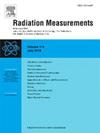开发一个独立的和交互式的康普顿相机系统,使用双阵列的单闪烁基于相机模块
IF 2.2
3区 物理与天体物理
Q2 NUCLEAR SCIENCE & TECHNOLOGY
引用次数: 0
摘要
为了解决传统康普顿相机视场受限、固有检测效率低等问题,开发了一种集成双模块康普顿相机系统(IDM-CCS)。IDM-CCS由两个基于闪烁体的模块组成,可独立交互运行,使用多系统加权列表模式最大似然期望最大化(LM-MLEM)算法增强图像重建。在交互(巧合)模式下,第一和第二反应发生在不同的检测器模块中。这样就可以通过修改探测器的几何形状来调整杠杆臂距离,即第一反应和第二反应之间的距离;实验是在不同的杠杆臂距离进行的。最小可分辨角评估表明,在单闪烁体模块的情况下,光源分离在24°时明显改善。在短、中、长杠杆臂距离下,轴向辐射源方向的固有成像效率分别为2.1%、1.3%和0.8%。同时,对于横向方向,在所有杆臂距离上,效率保持稳定在1.3%左右。现场可用性测试证实,当IDM-CCS的像素分辨率与标准相机(如智能手机中使用的相机)的像素分辨率一致时,两种不同辐射源的位置被准确地表示出来。研究结果可为同类结构探测器的优化提供指导,从而提高探测器在各种领域的应用性能。本文章由计算机程序翻译,如有差异,请以英文原文为准。
Development of an independent and interactive compton camera system using dual arrays of single scintillator-based camera modules
An integrated dual-module Compton camera system (IDM-CCS) was developed to address the limitations of conventional Compton cameras, such as restricted field-of-view (FOV) and low intrinsic detection efficiency. The IDM-CCS, which comprises two single scintillator-based modules, operates both independently and interactively, using the multi-system weighted list-mode maximum likelihood expectation maximization (LM-MLEM) algorithms for enhanced image reconstruction. In the interactive (coincidence) mode, the first and second reactions occurred in different detector modules. This enabled the adjustment of the lever arm distance, which was the distance between the first and second reactions, by modifying the detector geometry; the experiments were performed at various lever arm distances.
A minimum resolvable angle assessment showed an improvement in the case of single scintillator modules, with a distinct source separation at 24°. The intrinsic imaging efficiency for the axial radiation source direction was determined to be 2.1 %, 1.3 %, and 0.8 % for short, medium, and long lever arm distances, respectively. Meanwhile, for the lateral direction, the efficiency remained stable at approximately 1.3 % across all lever arm distances. Field usability tests confirmed that when the pixel resolution of the IDM-CCS was aligned with that of standard cameras, such as those used in smartphones, the positions of the two different radiation sources were accurately represented. The study findings can offer guidance for optimizing detectors with similar structures, thereby enhancing their performance in various field applications.
求助全文
通过发布文献求助,成功后即可免费获取论文全文。
去求助
来源期刊

Radiation Measurements
工程技术-核科学技术
CiteScore
4.10
自引率
20.00%
发文量
116
审稿时长
48 days
期刊介绍:
The journal seeks to publish papers that present advances in the following areas: spontaneous and stimulated luminescence (including scintillating materials, thermoluminescence, and optically stimulated luminescence); electron spin resonance of natural and synthetic materials; the physics, design and performance of radiation measurements (including computational modelling such as electronic transport simulations); the novel basic aspects of radiation measurement in medical physics. Studies of energy-transfer phenomena, track physics and microdosimetry are also of interest to the journal.
Applications relevant to the journal, particularly where they present novel detection techniques, novel analytical approaches or novel materials, include: personal dosimetry (including dosimetric quantities, active/electronic and passive monitoring techniques for photon, neutron and charged-particle exposures); environmental dosimetry (including methodological advances and predictive models related to radon, but generally excluding local survey results of radon where the main aim is to establish the radiation risk to populations); cosmic and high-energy radiation measurements (including dosimetry, space radiation effects, and single event upsets); dosimetry-based archaeological and Quaternary dating; dosimetry-based approaches to thermochronometry; accident and retrospective dosimetry (including activation detectors), and dosimetry and measurements related to medical applications.
 求助内容:
求助内容: 应助结果提醒方式:
应助结果提醒方式:


